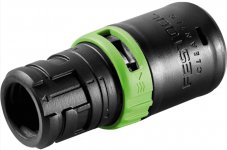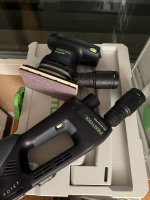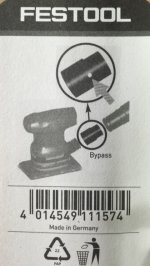Used my RO 90 for the first time yesterday and hooked it up with a new smooth hose to my Midi. Worked great but when it came to take off the hose, I can't get it off. It went on easily and fully (all the way to the end of the connector). The hose is new to me as well and I've tried to twist it off, etc. without success. There is nothing in the instruction booklet and nothing on-line that I could find. What am I doing wrong?
You are using an out of date browser. It may not display this or other websites correctly.
You should upgrade or use an alternative browser.
You should upgrade or use an alternative browser.
Removing Dust Extraction hose from RO 90
- Thread starter RonMiller
- Start date
Crazyraceguy
Member
- Joined
- Oct 16, 2015
- Messages
- 5,559
I almost never fully install these newer style hoses, with the twist-lock feature, much preferring the older version with the ridges inside. The rotation has to be in a specific position to get it on, where the others didn't require that. The rubber also seems stiffer too.
My favorite thing to plug into is the MFK700, it is a smooth cylinder and very easy to work.
The others are the newer OF1010 and the aftermarket fittings for the TS55. They are both internal fit though.
My favorite thing to plug into is the MFK700, it is a smooth cylinder and very easy to work.
The others are the newer OF1010 and the aftermarket fittings for the TS55. They are both internal fit though.
ElectricFeet
Member
- Joined
- Feb 4, 2017
- Messages
- 301
It doesn’t get any easier with time — either in terms of flexibility of the rubber or our age ;DRonMiller said:Well, some hard twisting and pulling got it off. I think this was a combination of a new hose on a new tool and 68 year old (lack of) strength!
When sanding with dust extraction, it’s always a good idea to let some air in, so that the sander doesn’t clamp itself to the surface. Festool sell these sleeve connectors (part number 577162) for this purpose.
View attachment 1
They have the very useful side effect of being rigid and very easy to fit the D27 hose into. I keep these (this new version and the older, non-adjustable version) permanently attached to my 2 sanders, just to avoid having to wrestle with the hose end every time.
Edited to add: The old connector (#204822) was better for this, as it had a proper bayonet that was rigid and easy to use. The new one is really designed to go on the end of a hose. But if you insert the ring into the end, it accepts a D27 pretty solidly.
If you can find anyone who still has #204822 in stock, it’s worth picking one up.
Attachments
^You have got to be kidding...
You take the hose out of the hose-end instead of the whole hose off the sander? That makes zero sense.
What hose and what generation RO90? The newer tools and hoses have a bayonet that is annoying for everyone not used to them. The bayonet hose ends also restrict the airflow more because the cross section is reduced even more.
And then they made it even worse; bigger and heavier, with the bypass valve...
You take the hose out of the hose-end instead of the whole hose off the sander? That makes zero sense.
What hose and what generation RO90? The newer tools and hoses have a bayonet that is annoying for everyone not used to them. The bayonet hose ends also restrict the airflow more because the cross section is reduced even more.
And then they made it even worse; bigger and heavier, with the bypass valve...
ElectricFeet
Member
- Joined
- Feb 4, 2017
- Messages
- 301
Coen said:^You have got to be kidding...
You take the hose out of the hose-end instead of the whole hose off the sander? That makes zero sense.
What hose and what generation RO90? The newer tools and hoses have a bayonet that is annoying for everyone not used to them. The bayonet hose ends also restrict the airflow more because the cross section is reduced even more.
And then they made it even worse; bigger and heavier, with the bypass valve...
I agree that this would make zero sense, and it’s not what I’m doing [big grin]
I keep these old-style adapters permanently attached to the sanders. They were designed exactly for this purpose by Festool. It’s really quick and easy to insert the bayonets into them because they are rigid and relatively roomy. The bayonets can be turned easily. They weigh virtually nothing and in any case, the hose is where the real weight is.
Compare that to wrestling the rubber bayonet off the RO90 — which as [member=7239]RonMiller[/member] found out is almost impossible if you don’t have strong hands (I don’t) — and it’s a dream solution.
There is zero reduction in hose width, but in any case, the whole point of these connectors is to introduce air into the system in order to reduce suction at the sander.
Perhaps it’s not clear what I do to the new adapters from the edit I made above. Basically, the new adapters can be made to work like the old ones. There’s no bayonet to turn into, so it’s like the old-school hoses, but it’s a really snug fit and doesn’t fall out.
Here they are in action. First the old ones — specifically designed by Festool to work like this, then the new one, adapted by me. (I haven’t attached the new one to the sander because that would mean having to wrestle one of the old ones off, which is a pain.)
View attachment 1
View attachment 2
View attachment 3
Attachments
Crazyraceguy
Member
- Joined
- Oct 16, 2015
- Messages
- 5,559
It might be easy, but it certainly looks stiff and cumbersome. [big grin]
ElectricFeet said:Coen said:^You have got to be kidding...
You take the hose out of the hose-end instead of the whole hose off the sander? That makes zero sense.
What hose and what generation RO90? The newer tools and hoses have a bayonet that is annoying for everyone not used to them. The bayonet hose ends also restrict the airflow more because the cross section is reduced even more.
And then they made it even worse; bigger and heavier, with the bypass valve...
I agree that this would make zero sense, and it’s not what I’m doing [big grin]
I keep these old-style adapters permanently attached to the sanders. They were designed exactly for this purpose by Festool. It’s really quick and easy to insert the bayonets into them because they are rigid and relatively roomy. The bayonets can be turned easily. They weigh virtually nothing and in any case, the hose is where the real weight is.
Compare that to wrestling the rubber bayonet off the RO90 — which as [member=7239]RonMiller[/member] found out is almost impossible if you don’t have strong hands (I don’t) — and it’s a dream solution.
There is zero reduction in hose width, but in any case, the whole point of these connectors is to introduce air into the system in order to reduce suction at the sander.
Perhaps it’s not clear what I do to the new adapters from the edit I made above. Basically, the new adapters can be made to work like the old ones. There’s no bayonet to turn into, so it’s like the old-school hoses, but it’s a really snug fit and doesn’t fall out.
Here they are in action. First the old ones — specifically designed by Festool to work like this, then the new one, adapted by me. (I haven’t attached the new one to the sander because that would mean having to wrestle one of the old ones off, which is a pain.)
View attachment 1
View attachment 2
View attachment 3
Thanks for clarifying. It's different than the way I read it. But it still makes no sense.
But at least I can count you in the 'don't like the bayonet' camp.
ElectricFeet
Member
- Joined
- Feb 4, 2017
- Messages
- 301
There’s a discussion of the even more previous version, which was available in 2016, here:https://www.festoolownersgroup.com/festool-tools-accessories/dts400-problems/?all with this pic, courtesy of [member=44099]Cheese[/member]:Coen said:Thanks for clarifying. It's different than the way I read it. But it still makes no sense.
But at least I can count you in the 'don't like the bayonet' camp.
[attachimg=1]
Then came the versions I pictured above.
So Festool’s solution for introducing air went from a simple non-bayonet adapter between the hose and the tool, to a more complex bayonet adapter between the hose and the tool, and now they’ve moved on to attaching it to the end of the hose instead.
Have to say that I agree with the comment on the other thread that this bleed valve should be on the tool itself.
But in the meantime, the adapter solves the problem of not being able to get the hose on and off the RO 90 ;D
As for the no bayonet camp: yup. But I’d be firmly in the bayonet camp if they had designed the tolerances and materials differently. As a concept, it’s fine, but not when using a tough, high-friction rubber that is bent out of shape to being almost triangular from the factory. And everything’s way too tight. Only the very end needs to be tight, not the whole connector. Add dust, which reduces the friction even more and it’s an absurd design. (Sorry, bit of a rant here.)
It is, but to be honest it works really well on the RO90. The machine itself is really badly balanced, falling over to the back. You either have to press down hard at the sander end — never good for sanding — or hold your other hand on the connector sleeve. You can see here how Sedge holds it by the connector sleeve when he’s using it:Crazyraceguy said:It might be easy, but it certainly looks stiff and cumbersome. [big grin]
[attachimg=2]
I find that the adapter gives me more area to hold on to at the back and it makes for a better sanding expereience ;D ;D ;D
The RTS 400, on the other hand, is so wonderfully well-balanced that the adapter makes no difference in use.
Attachments
Similar threads
- Replies
- 29
- Views
- 845
- Replies
- 17
- Views
- 1K
- Replies
- 15
- Views
- 337
- Replies
- 2
- Views
- 131K






